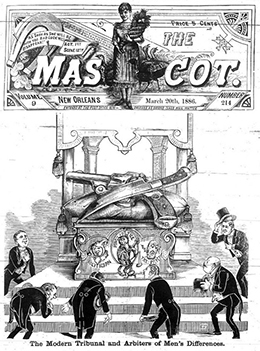| << Chapter < Page | Chapter >> Page > |

The dispute between South Carolina’s James Hammond and his erstwhile friend (and brother-in-law) Wade Hampton II illustrates the southern culture of honor and the place of the duel in that culture. A strong friendship bound Hammond and Hampton together. Both stood at the top of South Carolina’s society as successful, married plantation owners involved in state politics. Prior to his election as governor of the state in 1842, Hammond became sexually involved with each of Hampton’s four teenage daughters, who were his nieces by marriage. “[A]ll of them rushing on every occasion into my arms,” Hammond confided in his private diary, “covering me with kisses, lolling on my lap, pressing their bodies almost into mine . . . and permitting my hands to stray unchecked.” Hampton found out about these dalliances, and in keeping with the code of honor, could have demanded a duel with Hammond. However, Hampton instead tried to use the liaisons to destroy his former friend politically. This effort proved disastrous for Hampton, because it represented a violation of the southern code of honor. “As matters now stand,” Hammond wrote, “he [Hampton]is a convicted dastard who, not having nerve to redress his own wrongs, put forward bullies to do it for him. . . . To challenge me [to a duel] would be to throw himself upon my mercy for he knows I am not bound to meet him [for a duel].” Because Hampton’s behavior marked him as a man who lacked honor, Hammond was no longer bound to meet Hampton in a duel even if Hampton were to demand one. Hammond’s reputation, though tarnished, remained high in the esteem of South Carolinians, and the governor went on to serve as a U.S. senator from 1857 to 1860. As for the four Hampton daughters, they never married; their names were disgraced, not only by the whispered-about scandal but by their father’s actions in response to it; and no man of honor in South Carolina would stoop so low as to marry them.
The antebellum South was an especially male-dominated society. Far more than in the North, southern men, particularly wealthy planters, were patriarchs and sovereigns of their own household. Among the white members of the household, labor and daily ritual conformed to rigid gender delineations. Men represented their household in the larger world of politics, business, and war. Within the family, the patriarchal male was the ultimate authority. White women were relegated to the household and lived under the thumb and protection of the male patriarch. The ideal southern lady conformed to her prescribed gender role, a role that was largely domestic and subservient. While responsibilities and experiences varied across different social tiers, women’s subordinate state in relation to the male patriarch remained the same.

Notification Switch
Would you like to follow the 'U.s. history' conversation and receive update notifications?